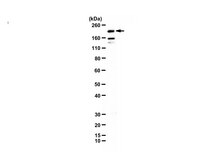ABE2620 Sigma-AldrichAnti-CEP152 Antibody, C-Terminal
Anti-CEP152, C-Terminal, Cat. No. ABE2620, is a highly specific rabbit polyclonal antibody that targets Centrosomal protein of 152 kDa and has been tested in Immunofluorescence and Western Blotting.
More>> Anti-CEP152, C-Terminal, Cat. No. ABE2620, is a highly specific rabbit polyclonal antibody that targets Centrosomal protein of 152 kDa and has been tested in Immunofluorescence and Western Blotting. Less<<Recommended Products
Overview
| Replacement Information |
|---|
Key Spec Table
| Species Reactivity | Key Applications | Host | Format | Antibody Type |
|---|---|---|---|---|
| H | IF, WB | Rb | Purified | Polyclonal Antibody |
| References |
|---|
| Product Information | |
|---|---|
| Format | Purified |
| Presentation | Purified rabbit polyclonal antibody in buffer containing 0.1M Tris-Glycine, 0.15M NaCl, 0.05% sodium azide, pH7.4 with 0.05% sodium azide. |
| Quality Level | MQ100 |
| Physicochemical Information |
|---|
| Dimensions |
|---|
| Materials Information |
|---|
| Toxicological Information |
|---|
| Safety Information according to GHS |
|---|
| Safety Information |
|---|
| Storage and Shipping Information | |
|---|---|
| Storage Conditions | Stable for 1 year at 2-8°C from date of receipt. |
| Packaging Information | |
|---|---|
| Material Size | 100 μg |
| Transport Information |
|---|
| Supplemental Information |
|---|
| Specifications |
|---|
| Global Trade Item Number | |
|---|---|
| Catalogue Number | GTIN |
| ABE2620 | 04054839193644 |
Documentation
Anti-CEP152 Antibody, C-Terminal SDS
| Title |
|---|
Anti-CEP152 Antibody, C-Terminal Certificates of Analysis
| Title | Lot Number |
|---|---|
| Anti-CEP152, C-Terminal - 3929347 | 3929347 |
| Anti-CEP152, C-Terminal - 3999524 | 3999524 |
| Anti-CEP152, C-Terminal Polyclonal Antibody | Q2833923 |







